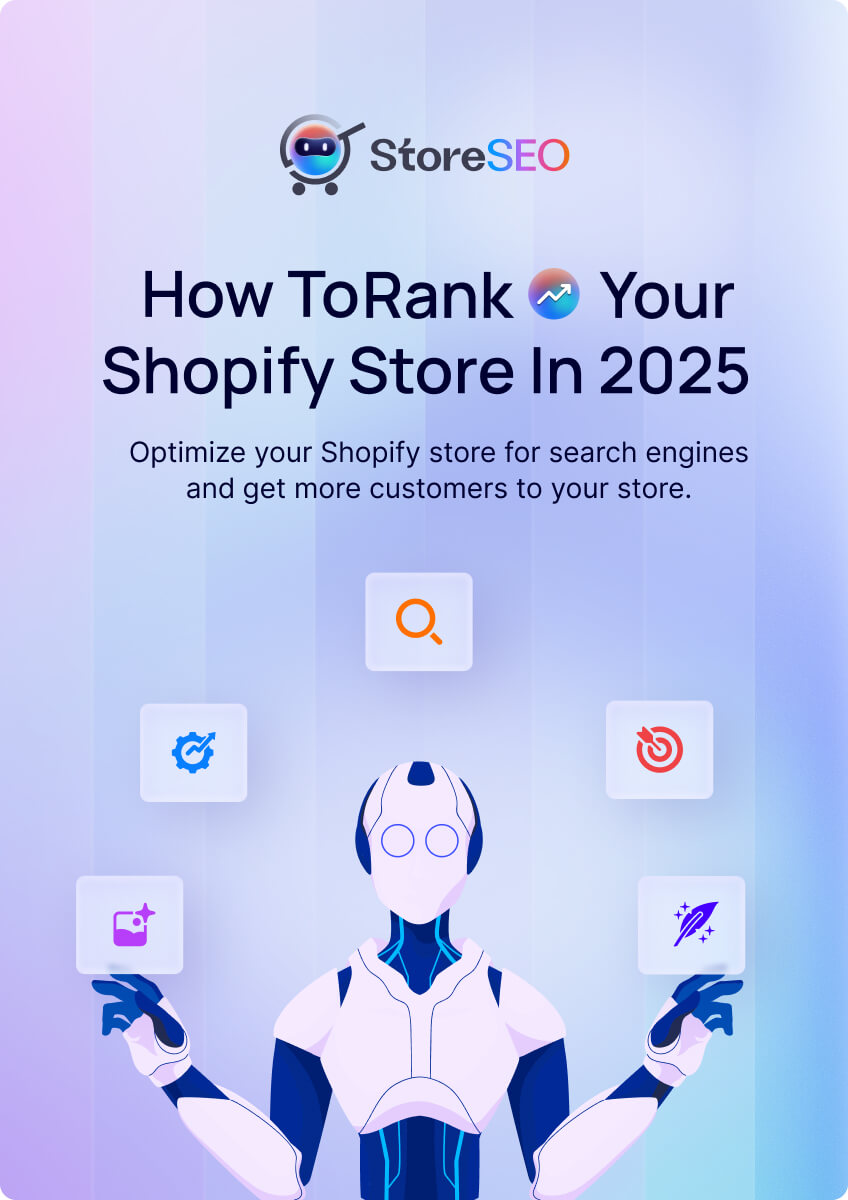Kunstmatige intelligentie verandert het zoeklandschap. Met AI-gestuurde zoekmachines zoals Google Search Generative Experience en opkomende tools zoals ChatGPT zijn traditionele SEO-strategieën onvoldoende. Voor Shopify-winkeleigenaren is het optimaliseren van een blog voor AI-zoekmachines is essentieel om zichtbaarheid te behouden, organisch verkeer te genereren en conversies te verhogen in 2025 en daarna.

Deze blog legt uit hoe je een Shopify-blog klaarmaakt voor AI-zoekmachines met bruikbare, datagestuurde strategieën. Het behandelt waarom AI-zoekopdrachten belangrijk zijn, hoe ze verschillen van traditionele zoekacties en geeft stapsgewijze tactieken om blogcontent te optimaliseren voor dit nieuwe tijdperk, met behulp van de ingebouwde tools van Shopify en de inzichten van StoreSEO om resultaten te maximaliseren.
Waarom AI-zoekmachines belangrijk zijn voor een Shopify-blog
AI-zoekmachines matchen niet alleen zoekwoorden; ze begrijpen ook de context, de intentie van gebruikers en conversatievragen. In tegenstelling tot traditioneel zoeken, dat sterk afhankelijk is van exacte zoekwoorden en backlinks, geeft AI-zoeken prioriteit aan natuurlijke taalverwerking, semantisch begrip en gebruikerservaring. Voor Shopify-blogs betekent deze verschuiving:
- Conversatievragen dominerenGebruikers stellen volledige vragen, zoals "Wat is de beste milieuvriendelijke yogamat voor beginners?" in plaats van "milieuvriendelijke yogamat" te typen.
- Het aantal zoekopdrachten zonder klikken neemt toe:AI-zoekmachines geven vaak directe antwoorden in de zoekresultaten, waardoor het aantal klikken naar websites afneemt, tenzij de inhoud zeer relevant en gezaghebbend is.
- Diepte van de inhoud is cruciaal:AI geeft de voorkeur aan uitgebreide, goed gestructureerde content die vragen grondig beantwoordt en aansluit bij de bedoeling van de gebruiker.
Stapsgewijze handleiding voor het optimaliseren van een Shopify-blog voor AI-zoekopdrachten
Om een Shopify-blog voor te bereiden op AI-zoekopdrachten, doelgerichte conversatievragen te beantwoorden, uitgebreide content te creëren met semantische trefwoorden en te demonstreren ETEN (Ervaring, Expertise, Autoriteit, Betrouwbaarheid). Gebruik de tools van Shopify en de inzichten van StoreSEO om de structuur en visuals te optimaliseren. Volg de onderstaande stapsgewijze handleiding voor gedetailleerde optimalisatietips.
1. Conversatiegerichte zoekopdrachten
AI-zoekmachines excelleren in het verwerken van long-tail, vraaggestuurde zoekopdrachten. Om te ranken, moet een Shopify-blog zich richten op deze conversatiezinnen, die ook bekend als trefwoorden.

Hoe je het doet:
- AI-zoekmachines geven prioriteit aan longtail, vraaggebaseerde zoekwoorden die weerspiegelen hoe gebruikers van nature vragen stellen. Om hoger te scoren, moet je Shopify-blog zich richten op deze conversatievragen.
- Gebruik tools zoals AnswerThePublic of X om specifieke vragen binnen jouw niche te identificeren, zoals "Wat zijn de beste milieuvriendelijke sneakers voor 2025?". Schrijf blogberichten die deze vragen direct beantwoorden met duidelijke, conversatiegerichte content, waarbij je de exacte bewoordingen verwerkt in titels, koppen en metabeschrijvingen.
- Optimaliseer met schema's, beknopte antwoorden voor gesproken zoekopdrachten en visuele elementen zoals productvergelijkingstabellen. Werk de content regelmatig bij om relevant te blijven en monitor de prestaties met Google Analytics om het verkeer en de conversies van deze zoekwoorden te volgen.
Voorbeeld: Voor een Shopify-winkel die huidverzorgingsproducten verkoopt, maak je een blogpost met de titel "Hoe je een huidverzorgingsroutine voor de gevoelige huid in 2025 opbouwt", gericht op de vraag "Wat is de beste huidverzorgingsroutine voor de gevoelige huid?"
2. Creëer uitgebreide, intentiegedreven content
AI-zoekmachines geven prioriteit aan content die volledig aansluit bij de zoekopdracht van de gebruiker. Blogberichten moeten grondig zijn, gestructureerd en afgestemd op de zoekintentie, of deze nu informatief, navigatie of commercieel is.

Hoe je het doet:
- Volg de omgekeerde piramideBegin met de belangrijkste informatie, zoals een kort antwoord op de vraag, gevolgd door een gedetailleerde uitleg. Een bericht over "Hoe kies je hardloopschoenen?" begint bijvoorbeeld met een samenvatting van belangrijke factoren, zoals pasvorm, demping en terrein.
- Gebruik semantische trefwoorden: Gebruik gerelateerde termen en synoniemen om de relevantie van het onderwerp te vergroten. Vermeld in een bericht over hardloopschoenen op natuurlijke wijze 'ondersteuning voor de voetboog', 'trailrunning' en 'demping', aangezien AI-zoekmachines natuurlijke taalverwerking gebruiken om de context te begrijpen.
- Behandel subonderwerpen grondig: Voer een Content Gap Analysis uit om subonderwerpen te identificeren die door toppagina's worden behandeld. Een bericht over "milieuvriendelijke yogamatten" kan bijvoorbeeld secties bevatten over materialen, duurzaamheid en onderhoudstips.
Shopify-tipGebruik de ingebouwde blogeditor van Shopify om berichten te structureren met duidelijke H2- en H3-koppen. Voeg een inhoudsopgave toe met apps zoals Easy TOC om de navigatie te verbeteren en de diepte van AI-zoekmachines te benadrukken.
Voorbeeld: Schrijf voor een Shopify-winkel die dierenbenodigdheden verkoopt een gids van 2000 woorden over "Hoe kies je het beste hondenvoer voor puppy's?", waarin ingrediënten, ras-specifieke behoeften en voedingsschema's worden behandeld, met een FAQ-sectie waarin vragen als "Mogen puppy's volwassen hondenvoer eten?" worden beantwoord.
3. Toon EEAT (Ervaring, Deskundigheid, Autoriteit, Betrouwbaarheid)
AI-zoekmachines geven prioriteit aan content van betrouwbare bronnen. Voor Shopify-blogs creëert het tonen van EEAT vertrouwen bij gebruikers en algoritmen.
Hoe je het doet:
- Toon expertise: Voeg biografieën van de auteurs en referenties toe. Als een Shopify-winkel bijvoorbeeld fitnessartikelen verkoopt, laat dan een gecertificeerde trainer blogposts schrijven of beoordelen.
- Gebruik ervaring uit de eerste hand: Deel casestudy's of inzichten uit producttests. Een bericht over "De beste weerstandsbanden voor thuisworkouts" kan bijvoorbeeld een experiment van 30 dagen met de producten van de winkel bevatten.
- Bouw actuele autoriteit op: Creëer contentclusters rond een niche. Schrijf voor een koffiezaak onderling verbonden berichten over zetmethoden, soorten koffiebonen en espressomachines, en koppel deze intern aan elkaar om expertise te signaleren aan AI-algoritmen.
- Vertrouwenssignalen toevoegen: Voeg beoordelingen van klanten, productcertificeringen, zoals USDA Organic, en links naar betrouwbare bronnen, zoals onderzoeken of blogs uit de sector, toe.
Voorbeeld: Publiceer voor een Shopify-winkel die biologische thee verkoopt een bericht van een theesommelier met de titel "Waarom biologische groene thee beter is voor uw gezondheid". Vermeld hierin onderzoeken en link naar productpagina's met getuigenissen van klanten.
4. Verbeter de inhoud met visuele elementen en gestructureerde gegevens
AI-zoekmachines geven de voorkeur aan inhoud met rijke media en gestructureerde gegevens omdat deze de gebruikerservaring verbeteren en algoritmes helpen bij het verwerken van informatie.

Hoe je het doet:
- Voeg hoogwaardige beelden toe: Voeg productafbeeldingen, infographics of video's toe aan blogposts. Een bericht over "Hoe style je oversized truien" kan bijvoorbeeld een videotutorial of outfitfoto's bevatten met Shopify-producten.
- Gebruik gestructureerde gegevens: Implementeren schema-opmaak, zoals FAQPage, HowTo of Product, om AI-zoekmachines te helpen content te begrijpen. Gebruik Shopify-apps zoals Schema Plus om gestructureerde data toe te voegen zonder te hoeven programmeren.
- Afbeeldingen optimaliserenOptimaliseer afbeeldingen zodat ze snel laden met behulp van apps als StoreSEO en voeg beschrijvende alt-tekst toe met semantische trefwoorden, zoals 'vrouw in oversized kasjmieren trui' in plaats van 'trui-afbeelding'.
Shopify-tip: Sluit Shopify-productcarrousels in blogberichten in met behulp van de ingebouwde productblokkeringsfunctie van Shopify om rechtstreeks naar de winkel te linken en zo de conversies te verhogen.
Voorbeeld: Voor een Shopify-winkel die keukengadgets verkoopt, maak je een bericht over 'Een spiraalsnijder gebruiken voor gezonde maaltijden' met een stapsgewijze video, schemamarkeringen voor het gedeelte 'Hoe te' en een productcarrousel met een link naar de spiraalsnijder.
5. Gebruik de blogfuncties van Shopify voor AI-zoekopdrachten
Het blogplatform van Shopify biedt hulpmiddelen om de AI-zoekmachineoptimalisatie te verbeteren zonder dat er externe plug-ins nodig zijn.
Hoe je het doet:
- Optimaliseer URL'sZorg ervoor dat de URL's van blogberichten kort zijn en veel trefwoorden bevatten, zoals /blogs/nieuws/beste-milieuvriendelijke-yogamatten-2025.
- Gebruik tags en categorieën: Organiseer berichten met tags, zoals ‘yogamatten’ of ‘milieuvriendelijk’, om de interne linkstructuur en de actuele relevantie te verbeteren.
- Reacties inschakelenStimuleer de betrokkenheid van gebruikers via blogreacties, aangezien AI-zoekmachines betrokkenheidssignalen kunnen gebruiken om de kwaliteit van de content te beoordelen.
- Integreren met Shopify Analytics: Volg de prestaties van je blog om berichten met veel verkeer te identificeren en deze te verfijnen voor AI-zoekopdrachten.
Shopify-tip: Gebruik de SEO-apps van Shopify, zoals StoreSEO, om te controleren op ontbrekende metagegevens, gebroken linksof andere problemen die van invloed kunnen zijn op AI-zoekresultaten.
Voorbeeld: Voor een Shopify-winkel die kaarsen verkoopt, tagt u blogberichten zoals 'Hoe kiest u geurkaarsen voor ontspanning' met 'aromatherapie' en 'woondecoratie' en linkt u naar gerelateerde berichten over kaarsverzorging om een contentcluster te creëren.
6. Controleer en update de inhoud regelmatig
AI-zoekmachines waarderen actuele, relevante content. Door een Shopify-blog regelmatig te updaten, blijft deze concurrerend.
Hoe je het doet:
- Voer een site-audit uit: Controleer op verouderde inhoud of technische problemen, zoals verbroken links, die schadelijk kunnen zijn voor de AI-zoekresultaten.
- Topberichten vernieuwen: Werk statistieken bij, voeg nieuwe inzichten toe of breid secties uit op basis van nieuwe gerelateerde vragen. Vernieuw bijvoorbeeld een bericht uit 2024 over "Beste eiwitpoeders" met trends uit 2025.
- Hergebruik inhoud: Verander goed presterende blogberichten in X-threads of YouTube-video's om verkeer terug te leiden naar de Shopify-blog.
Shopify-tip: Gebruik de blogplanningsfunctie van Shopify om updates te plannen en een consistent publicatieritme te behouden.
Voorbeeld: Voor een Shopify-winkel die technische gadgets verkoopt, kun je een bericht over "Beste draadloze oordopjes voor hardlopen" updaten met nieuwe modellen en een link naar productpagina's. Deel vervolgens een samenvattende thread op X.
Veelgemaakte fouten om te vermijden
- Keyword stuffing: AI-zoekmachines straffen onnatuurlijk trefwoordgebruik af. Richt je in plaats daarvan op semantische relevantie.
- Dunne inhoudVermijd korte, oppervlakkige berichten. Streef naar 1500-2500 woorden voor concurrerende onderwerpen, aangezien gegevens van StoreSEO aangeven dat pagina's met een hoge ranking vaak meer dan 2000 woorden bevatten.
- Mobiele optimalisatie negerenShopify-blogs moeten mobielvriendelijk zijn, aangezien AI-zoekmachines prioriteit geven aan de gebruikerservaring op mobiele apparaten.
- Interne links verwaarlozen:Als u geen links plaatst naar gerelateerde blogberichten of productpagina's, vermindert u de autoriteit van het onderwerp en het conversiepotentieel.
Veelgestelde vragen over het voorbereiden van uw Shopify-blog op de opkomst van AI-zoekmachines
Wat zijn de verschillen tussen AI-zoekmachines en traditionele zoekmachines?
AI-zoekmachines gebruiken natuurlijke taalverwerking om context en conversatievragen te begrijpen, waarbij uitgebreide, intentie-gedreven content voorrang krijgt boven exacte zoekwoorden.
Kan de ingebouwde blog van Shopify concurreren met AI-zoekmachines?
Ja, het blogplatform van Shopify ondersteunt SEO-vriendelijke URL's, gestructureerde data en rich media, waardoor het geschikt is voor AI-zoekmachineoptimalisatie bij strategische inzet.
Hoe vaak moet een Shopify-blog worden bijgewerkt voor AI-zoekopdrachten?
Vernieuw de berichten met de hoogste prestaties elke 6 tot 12 maanden en gebruik hulpmiddelen zoals StoreSEO om nieuwe trefwoorden en trends te identificeren.
Zijn backlinks nog steeds belangrijk voor AI-zoekopdrachten?
Ja, maar hun belang is afgenomen. AI-zoekmachines geven prioriteit aan de kwaliteit van content en actuele autoriteit, hoewel backlinks van gerenommeerde websites de geloofwaardigheid nog steeds vergroten.
Optimaliseer uw Shopify-blog voor AI-zoekopdrachten met strategieën voor succes
AI-zoekmachines transformeren de manier waarop Shopify-winkeleigenaren organisch verkeer aantrekken. Door te focussen op conversatievragen, uitgebreide content te creëren, EEAT te demonstreren en de tools van Shopify te combineren met de inzichten van StoreSEO, kan een blog floreren in dit nieuwe tijdperk. Begin vandaag nog met het controleren van bestaande content met de Site Audit-tool van StoreSEO en richt je op één conversatievraag. Het organische verkeer en de conversies van de winkel zullen er aanzienlijk op vooruitgaan.
Als u hulp nodig heeft met StoreSEO, neem dan gerust contact met ons op. Neem contact op met ons supportteam. En voor meer spannende updates en nieuws, abonneer je op onze blogs. Succes!









